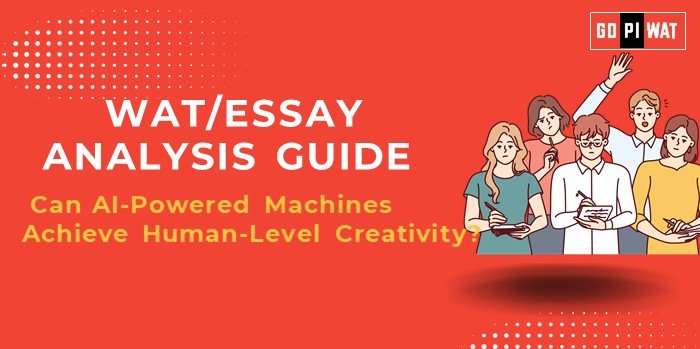📋 Written Ability Test (WAT) Analysis Guide
🤖 Topic: Can AI-Powered Machines Achieve Human-Level Creativity?
🌐 Understanding the Topic
AI-driven creativity introduces transformative opportunities and challenges. For B-school aspirants, this topic bridges innovation, strategy, and ethics, offering insights into managing disruptive technologies while preserving human uniqueness.
📝 Effective Planning and Writing
- ⏳ Time Allocation:
- Planning: 5 minutes
- Writing: 20 minutes
- Review: 5 minutes
- 📄 Structure:
- Introduction: 60-70 words
- Body: 350-375 words
- Conclusion: 60-70 words
💡 Introduction Techniques
- ⚖️ Contrast Approach: “While DALL-E 3 creates stunning visual art, the absence of emotional depth questions whether AI truly achieves human-level creativity.”
- ✨ Solution-Oriented Approach: “AI’s potential lies not in replacing human creativity but in enhancing it, fostering collaborative innovation.”
📊 Structuring the Essay Body
- ✅ Achievements: Discuss AI’s efficiency and scalability, citing data like generative AI’s projected $356.10 billion market size by 2030.
- ⚠️ Challenges: Highlight concerns like originality, job displacement, and ethical dilemmas, drawing on global examples like the EU’s copyright policies.
- 🚀 Future Outlook: Explore hybrid creativity models, regulatory frameworks, and the potential for ethical AI applications in industries.
🏁 Concluding Effectively
- ⚖️ Balanced Conclusion: “AI’s advancements enhance creativity but require ethical frameworks to ensure its impact is constructive and collaborative.”
- 🌏 Global Comparison Conclusion: “Japan’s use of AI in manga and DALL-E 3’s breakthroughs highlight AI’s creative potential, but global consensus on its ethical use is crucial.”
📈 Analyzing Successes and Shortcomings
- 🎨 Key Achievements: Scalability, innovation, accessibility.
- ⚠️ Ongoing Challenges: Lack of originality, ethical concerns, job market disruptions.
- 🌍 Global Context: AI adoption in Japan and the EU’s regulatory emphasis provide critical insights.
🔍 Recommendations for Sustainable Progress
- 🤝 Hybrid Creativity Models: Promote collaboration between AI and human inputs.
- ⚖️ Ethical Frameworks: Develop transparent regulatory guidelines for AI use.
- 📚 Upskilling Programs: Invest in training professionals in AI-disrupted industries.
📚 Sample Short Essays
- ✅ Balanced Perspective: “AI-powered machines extend the boundaries of creativity but lack the emotional depth unique to humans. Collaboration between AI and humans is the way forward.”
- ✨ Solution-Oriented: “Generative AI tools like DALL-E 3 complement human creativity, enabling scalable innovation across industries while preserving originality.”
- 🌏 Global Context: “With AI transforming creative industries worldwide, ethical frameworks and collaborative efforts will determine its role in achieving human-level creativity.”


